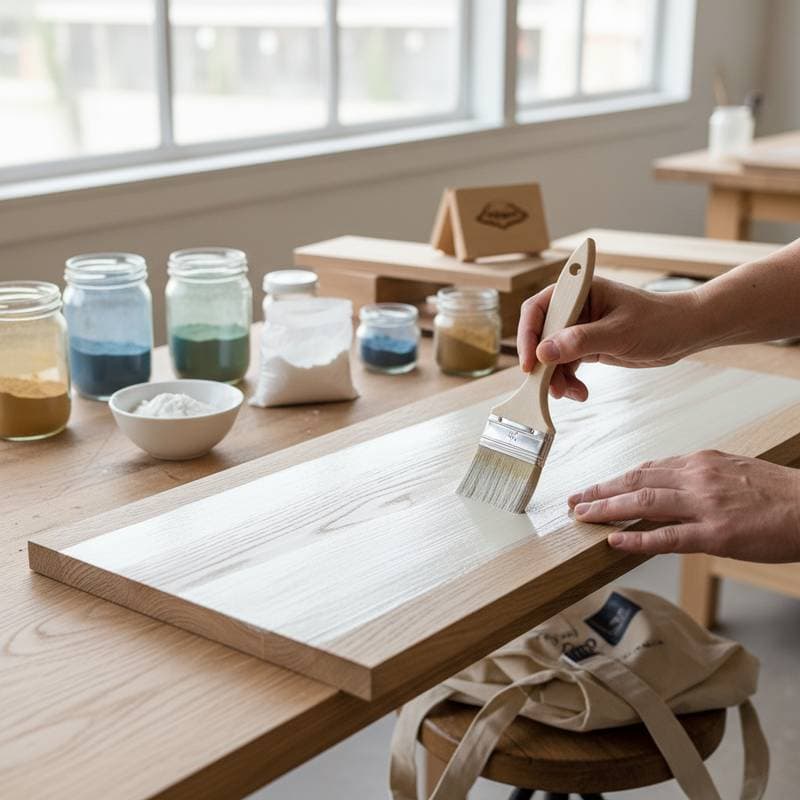Milk Paint Revives Wood Without Toxic Solvents
Milk paint experiences a resurgence in contemporary workshops. This ancient formula, composed of lime, casein, and pigments, predates modern synthetic finishes. Woodworkers now embrace it for its safety, breathability, and matte aesthetic that accentuates natural wood grain. The appeal lies in its environmental compatibility and the authentic texture it imparts.
Why Milk Paint Matters
The core ingredients of milk paint render it biodegradable and free of toxins. It lacks volatile organic compounds, permitting indoor application without extensive ventilation. The formula bonds directly with the wood surface, yielding a durable, chalky finish that resists peeling.
Designer Claire Mendoza notes, “When you brush on milk paint, it feels alive. It soaks in rather than sitting on top, which means the wood still feels like wood.” This integration preserves the wood's inherent character while enhancing visual depth.
Transitioning from Traditional Stains
Conventional stains deliver color through petroleum-based solvents, which can unevenly penetrate the wood and mask subtle patterns. Milk paint offers versatility in opacity: dilute it for a stain-like wash or apply multiple layers for full coverage. The resulting surface diffuses light softly, avoiding the artificial gloss of synthetic options.
Many workshops now stock milk paint powder, which remains viable indefinitely. Activate portions as needed with water to minimize waste and ensure color consistency. For a weathered appearance, dilute further or burnish the dried surface with a soft cloth.
Quick Reference Guide
- Finish Type: Natural milk paint with lime and casein base
- Ideal Applications: Furniture, cabinetry, paneling, decorative elements
- Application Methods: Brush, sponge, or spray with a fine nozzle
- Sheen Level: Matte, convertible to low satin via topcoat
- Cleanup Process: Soap and water
- Users: Small-batch furniture makers, restoration specialists, eco-conscious builders
- Image Credits: Studio photos from Woodcraft Visuals
Conventional Finishing Challenges
Traditional workflows involve sanding, staining, and sealing with polyurethane or lacquer. These methods produce uniform results but often blur grain details and introduce strong odors. Cabinetmaker Joel Kim recalls, “We would open the doors and wait for the fumes to settle. You got color, but you also got headaches.”
Such finishes carry environmental burdens, including disposal complexities and flammability hazards. Small studios increasingly seek options that maintain durability without added safety measures or regulatory hurdles.
Benefits of Milk Paint Application
Milk paint applies with a smooth, velvety consistency and dries to a tactile, flat surface. Pair it with natural wax or low-VOC sealers for enhanced protection and subtle luster. Mineral pigments provide nuanced color variations that capture light elegantly in photographs.
In workshop settings, the finish minimizes glare by absorbing rather than reflecting illumination. Sanding between coats softens edges, evoking a timeworn patina without artificial distressing. The final piece conveys craftsmanship authenticity.
Practical Application Details
- Core Materials: Lime, nonfat milk curd, earth-based pigments
- Mixing Ratio: Equal parts powder and water for optimal coverage
- Recommended Tools: Natural-bristle brush or foam applicator
- Drying Time: Approximately 30 minutes per coat, varying with humidity
- Topcoat Choices: Beeswax polish, linseed oil, or water-based varnish
- Storage Advice: Refrigerate mixed paint for up to two days
These elements support efficient, low-waste practices. Thin applications yield handcrafted appearances superior to machine-sprayed results.
Enhancing Light and Texture
Milk paint interacts uniquely with illumination, revealing warm tones in colors like slate blue or ocher. It accentuates joinery and tool marks, promoting transparency in construction. Woodworkers appreciate this fidelity to material truths.
Homeowners value the absence of lingering chemical scents. The breathable surface develops a natural patina over time, requiring only light touch-ups rather than complete refinishing.
Professional Application Steps
Step 1: Prepare the Surface
Sand to 150 grit to promote adhesion. Skip sealers or conditioners; milk paint adheres best to bare wood. Remove dust via vacuum and a damp cloth wipe.
Step 2: Mix and Test
Blend powder and water in a clean vessel until smooth, then rest for ten minutes. Test on a scrap piece to assess color and absorption. Modify with additional water for translucency or powder for density.
Step 3: Apply Thin Coats
Brush the initial layer along the grain with uniform strokes. Dry fully, then sand lightly with 320 grit. Add two to three coats for preferred opacity; expect a chalky interim appearance.
Step 4: Seal and Polish
After the last coat dries, rub in beeswax or oil using a lint-free cloth. Buff after one hour to deepen hues and boost resistance to stains.
Step 5: Ongoing Care
Clean with a damp cloth or mild soap solution. Renew wax periodically. The permeable nature prevents cracking amid humidity fluctuations.
Studio Efficiency Tips
- Store powder in airtight jars, shielded from moisture
- Label jars with color swatches for swift identification
- Prepare mixes in reusable glass for simple rinsing
- Repurpose remnants for experimental textures
These practices foster mindful workflows and organized spaces. Natural materials inspire deliberate, high-quality production.
Sustainability Advantages
Milk paint stands out for its renewable, nontoxic composition. Application and curing emit no harmful vapors. Water-based cleanup allows safe disposal, even in compost systems. It supports certifications like LEED by improving indoor air standards.
Environmental consultant Lina Duarte observes, “When you replace solvent finishes with milk paint, you cut emissions at the source. The air stays cleaner, and the workspace feels calmer.” This tranquility benefits both creators and end-users through subdued acoustics and visuals.
Coverage and Value
One quart of powder covers about 70 square feet with two coats. Costs range from 20 to 30 dollars per quart, influenced by pigment type. On-demand mixing curbs excess, and overall expenses decrease when accounting for eliminated disposal and gear needs.
Essential Insights for Woodworkers
- Milk paint prioritizes safety and sustainability over synthetic alternatives
- Its breathable bond preserves wood's natural feel and appearance
- Versatile application suits stains, paints, or washes
- Eco-friendly traits align with modern green building standards
- Long-term maintenance proves simple and effective
Adopting milk paint elevates projects with enduring, environmentally sound results.
